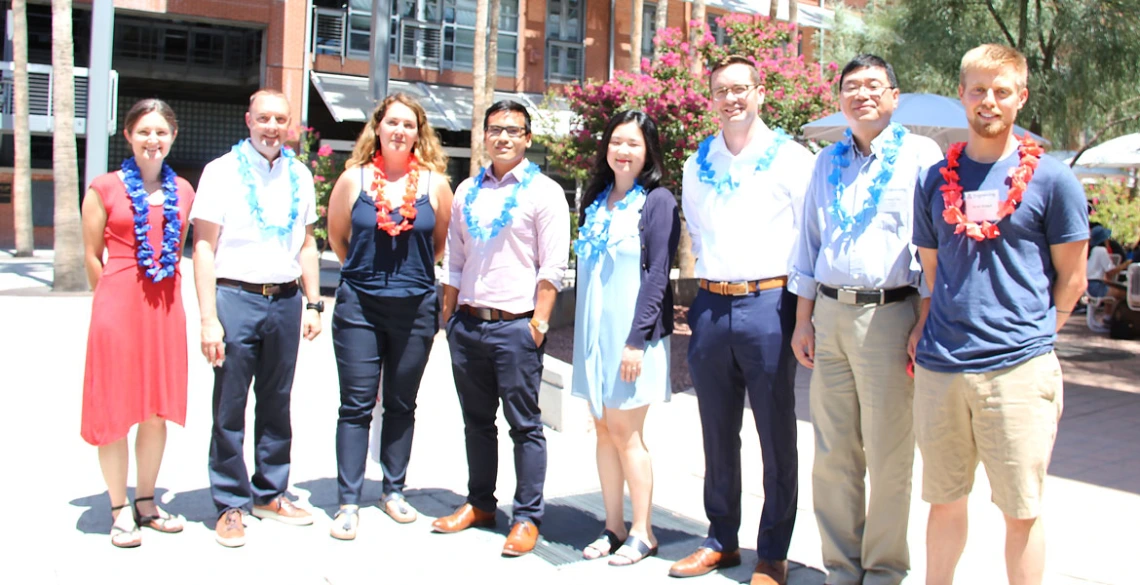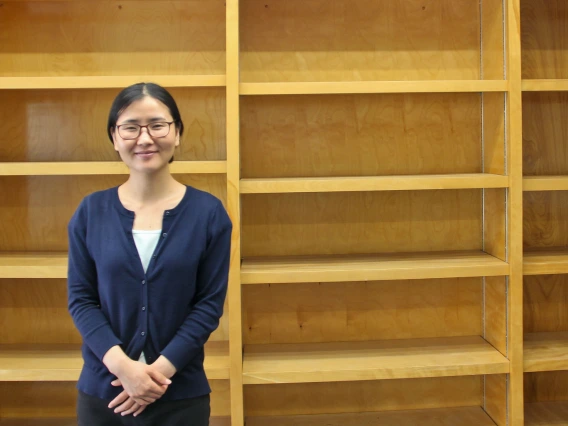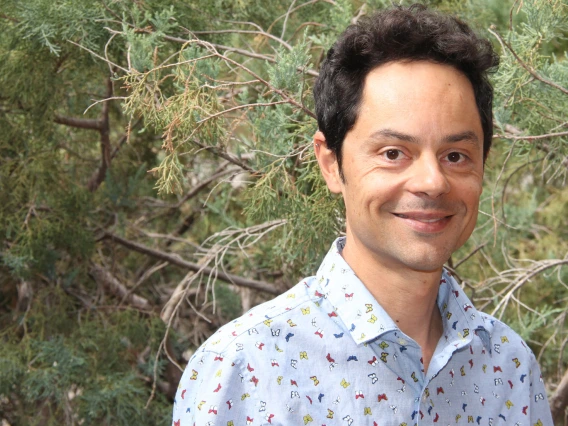New Faculty Join UA Engineering
The college welcomes nine tenure-track faculty members and several lecturers as the 2019-2020 academic year begins.

Some of the College of Engineering's newest faculty members at the annual Dean's Barbecue. (Photo: Brian Topping / UA Engineering Marketing and Communications)
The University of Arizona College of Engineering continues to advance its research and teaching strengths by adding faculty members in six departments in 2019. Their realms of expertise range from hypersonics to make aircraft faster, quantum information science to improve communications security, and wearable technologies to enhance the quality of human life.
Aerospace and Mechanical Engineering
Kyle Hanquist
Kyle Hanquist joins the UA Department of Aerospace and Mechanical Engineering as an assistant professor after earning his doctoral degree in aerospace engineering and completing a postdoctoral fellowship at the University of Michigan-Ann Arbor.
His research works to model complex phenomena, with a recent focus on computational hypersonics, including investigating cooling mechanisms for the leading edges of hypersonic vehicles flying at 5 miles per second. He’s still acclimating to the heat of Tucson after living in Michigan, but says it’s only fitting to live in the desert, since he studies high-temperature air.
"The UA really stood out compared to other opportunities,” he said. “The people both at the university and around town are super friendly, and my research aligned well with the department and local industry."
Bernard Parent
Bernard Parent comes to AME after 11 years as an associate professor of aerospace engineering at Pusan National University in South Korea.
His research focuses on the numerical simulation of plasma and reactive flows, such as those used in aerodynamic flow control. His laboratory has developed more computationally efficient methods for understanding plasma behavior in hypersonics, combustion and fuel reforming.
His biggest draw to the UA was his new department.
“There are several professors whose fields of expertise complement mine,” he said. “Collaborations make it possible to go after problems that would be impossible to tackle on my own.”
Biomedical Engineering
Elizabeth Hutchinson
Elizabeth Hutchinson, who holds a bachelor’s degree in physics and a doctorate in neuroscience, started in the Department of Biomedical Engineering after nearly seven years at the National Institutes of Health.
She looks forward to leading her own lab and interacting daily with students. She aims to increase the effect of neuroimaging on understanding and treating human brain disorders by using animal models. She worked with many BME faculty members in her time at NIH, and she said the UA’s sophisticated imaging facility is nearly unmatched.
“I have this combination of basic sciences, such as physics, and of neuroscience,” she said. “I’ve always wanted to bridge the two, and I think biomedical engineering emerged as a field that already has the capacity to do that.”
Jil Tardiff
Dr. Jil Tardiff has been on the faculty at the UA College of Medicine – Tucson, with a joint appointment in biomedical engineering, since 2012. Because the field fits well with her research in biophysics and drug delivery, she’s been increasing her involvement with BME over time -- even mentoring several graduate students. In fall 2019, her primary appointment moved to the department.
“The leadership in BME, and in engineering in general, is very strong and forward-looking,” she said. “It’s an exciting and growing department at the UA.”
Tardiff, a physician-scientist who is also the Gootter Endowed Chair for the Prevention of Sudden Cardiac Death, the director of the Hypertrophic Cardiomyopathy Clinic, and a member of the Sarver Heart Center and BIO5 Institute, looks forward to strengthening the ties between the College of Engineering and the College of Medicine.
Chemical and Environmental Engineering
Adrianna Brush
Adrianna Brush joined the Department of Chemical and Environmental Engineering in fall 2018 as a lecturer, after earning her PhD in chemical engineering at the University of Texas at Austin and serving a stint as a process developer at the Clorox Co.
At the UA, she’s been laser-focused on implementing evidence-based techniques like active learning. One reason she chose this position, in fact, was because she appreciated the university’s dedication to using these new methods in undergraduate education.
“I have been loving my time here working with undergraduates,” she said. “It’s very exciting to be part of a university, college and department that all embrace this vision.”
Byron Hempel
Byron Hempel completed both his master’s and doctoral degrees in chemical engineering at the UA. Now, he’s joining the department as a lecturer.
“I first came to the UA four years ago and have fallen in love with so many different things,” he said. “CHEE’s excellence in water research, in addition to the hidden gems of nature in Tucson, drew me here. The progressive teaching nature of the department and college have captured me to stay long term.”
In the lab, he examines advanced oxidation processes, methods for quantifying and discovering metabolites from fire exposure, and bioassays to allow for fast and scalable reuse of water. In the classroom, he’s researching ways to improve engineering education by helping foster factors like self-efficacy and growth mindsets among students.
Vicky Karanikola
After two years as a postdoctoral associate at Yale University, CHEE alumna and former UA postdoctoral researcher and assistant research professor Vicky Karanikola returns as an assistant professor. She’s ready to enjoy southwest living and her home department again.
Karanikola’s focus is on creating membrane-based water purification technologies with high selectivity for removing targeted contaminants. During her previous time at the UA, she collaborated with Engineers Without Borders to provide water treatment methods to rural populations such as Native Americans living on reservations -- work she plans to continue in her new role. She currently serves as vice president of the EWB Mountain Region Steering Committee.
“What brings me back is the sense of community, and the water research opportunities -- to work in an area that knows the impact of water scarcity firsthand,” she said. “During these challenging times, my advanced water treatment research provides insights into the interdependency between water production and energy.”
Suchol Savagatrup
New CHEE assistant professor Suchol Savagatrup earned his PhD in chemical engineering from the University of California, San Diego in 2016, and then completed a postdoctoral fellowship at the Massachusetts Institute of Technology in 2019.
His research lies at the intersection of soft materials design and device engineering, working primarily with materials such as polymers and emulsions. Emulsions like mayonnaise and makeup are present in our everyday lives, but Savagatrup aims to engineer versions with the ability to detect harmful agents like foodborne pathogens and toxic chemicals.
“I was impressed with the UA and the city of Tucson on my first visit,” he said. “The department is full of creative and energetic colleagues, and the students are bright and eager to learn.”
Songtao Xie
Songtao Xie joined CHEE as a lecturer in January 2019, after research and teaching roles at the University of Miami Miller School of Medicine, the Mayo Clinic’s Neural Imaging Lab and Texas A&M University. His past work involved investigating the development of electrochemical sensors for neurochemical detection.
In his new position, he’s looking forward to contributing to students’ success by helping them broaden their views of the world.
“The UA provides me with an opportunity to learn new teaching techniques like active learning, and to develop myself in a community setting,” he said. “I really enjoyed teaching several undergraduate classes last semester.”
Electrical and Computer Engineering
Quntao Zhuang
Quntao Zhuang joined the Department of Electrical and Computer Engineering in January 2019 after completing a postdoctoral fellowship at the University of California, Berkeley. He earned his PhD in physics from the Massachusetts Institute of Technology in 2018.
Though he studied physics, he selected Jeffrey Shapiro in MIT’s Department of Electrical Engineering and Computing Science as his doctoral adviser. Current UA faculty members Zheshen Zhang of the Department of Materials Science and Engineering and Saikat Guha of the College of Optical Sciences were also in Shapiro’s research group. The team researched quantum information science, which lies at the intersection of physics, computer science, communications and biology. Zhuang looks forward to continuing to apply quantum techniques to areas like secure communications and improved processing speeds.
“Here, I have good friends and many potential collaborators, so I think it’s a very good environment for me,” he said.
Materials Science and Engineering
Andrew Wessman
Andrew Wessman is the newest addition to the MSE faculty. An engineer at General Electric for nearly 14 years, he earned his PhD in materials science and engineering from the University of Cincinnati while working full time. He’s excited to embark on a tenure-track role where he can focus on research and development and interacting with students.
At the UA, he plans to explore additive manufacturing of materials in challenging environments, such as the hottest part of jet engines. He hopes to use his network of business connections and the UA’s proximity to companies like Honeywell and Raytheon to strengthen the college’s connection to industry.
“I looked around at a lot of universities, and I really like how the UA has sort of a 'whole university' approach to pursuing research funding,” he said. “It’s a nice ecosystem.”
Systems and Industrial Engineering
Sol Lim
Sol Lim is joining the Department of Systems and Industrial Engineering as an assistant professor after completing her PhD at the University of Michigan-Ann Arbor. She says her background in biomedical engineering, industrial engineering, and clothing and textiles have all contributed to her current research, which combines wearable technologies with data analytics and human factors.
For example, Lim has analyzed movement data from manual laborers to estimate the cumulative impact of physically demanding tasks and help mitigate work-related injuries. She’s also tracked the way individuals with disabilities move through public transportation, working to understand the physical and cognitive barriers that limit their independence. With this work, she aims to develop design guidelines to improve the accessibility of future autonomous transportation.
"The beauty of wearable sensors is that they can be used to collect human motion and physiological data in a range of environmental contexts with minimal interruption," she said. "My goal is to improve human health and quality of life through the effective use of wearable technologies."



